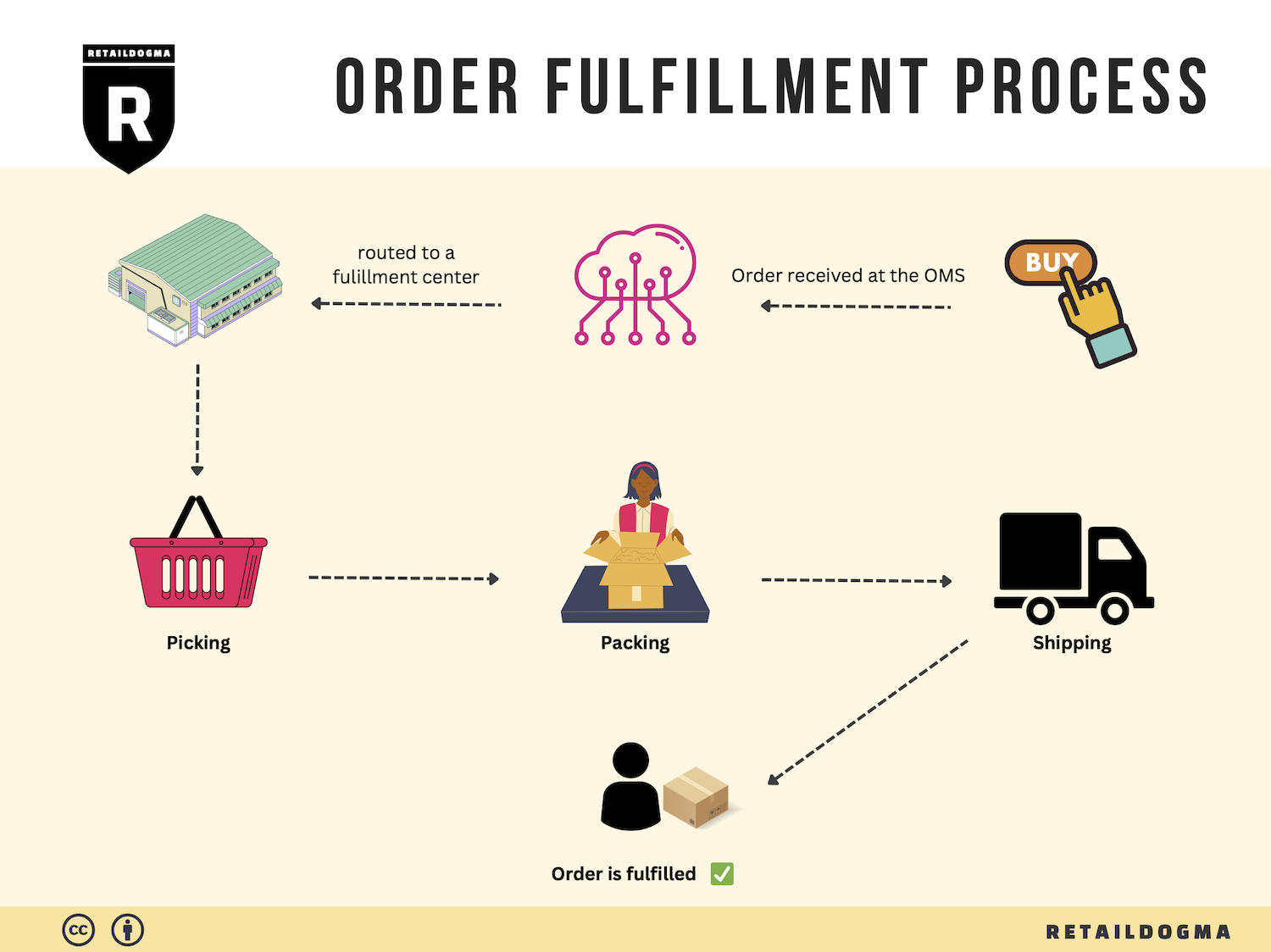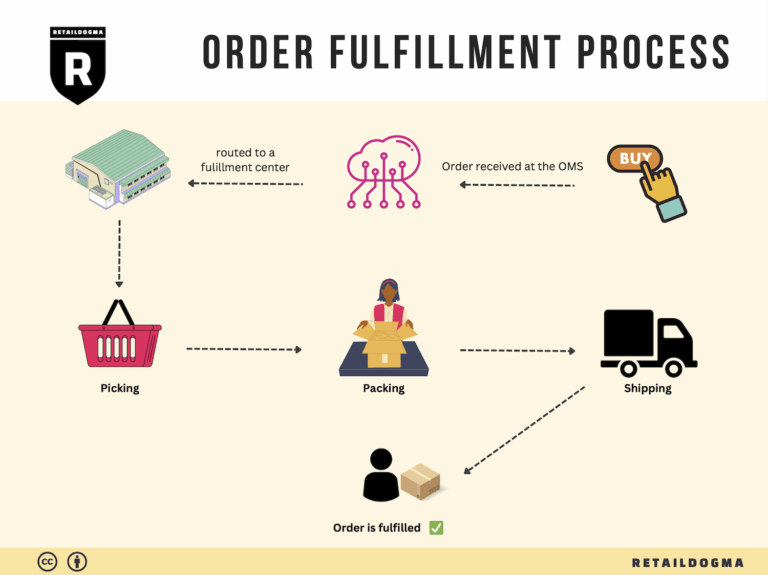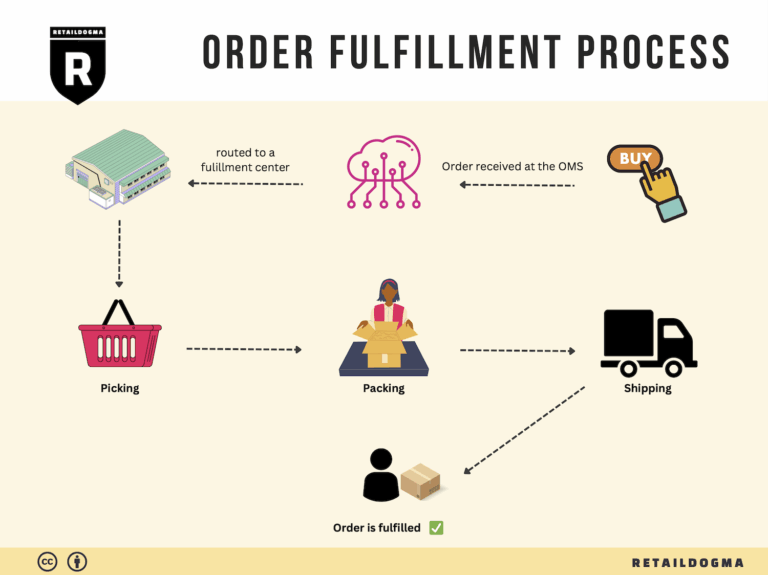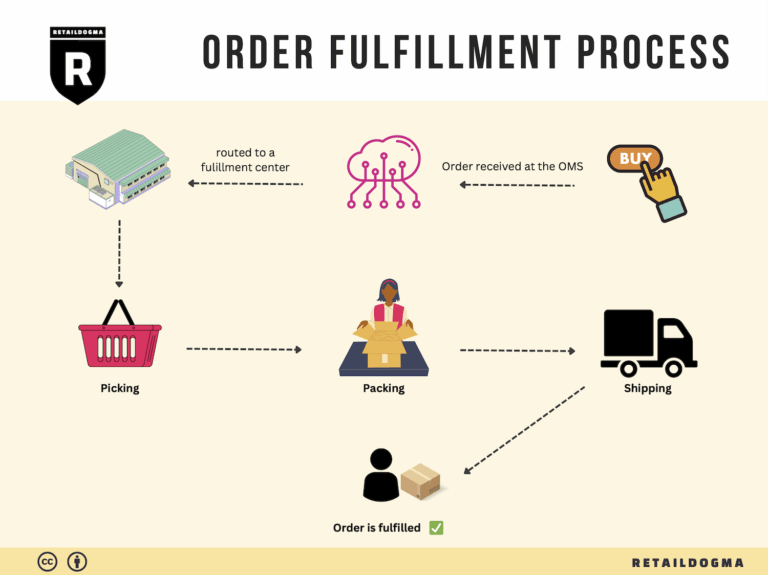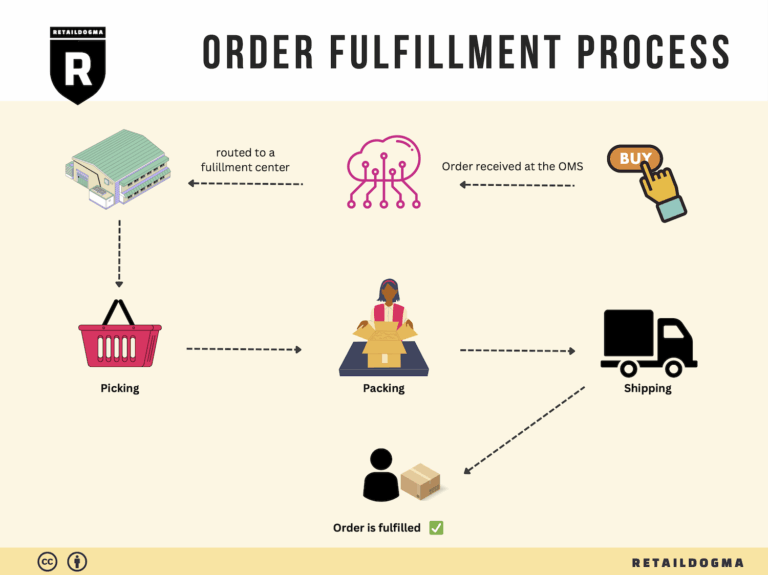Ecommerce Fulfillment Services: The Ultimate Guide (2025)
What is E-commerce Fulfillment? An Introduction for Growing Businesses
Understanding the Challenges of Order Fulfillment
As your e-commerce business begins to grow, the excitement of increasing sales can quickly be overshadowed by the daunting task of managing order fulfillment. Many business owners find themselves overwhelmed with the intricacies of packing and shipping orders, managing inventory, and ensuring customer satisfaction—all while trying to focus on scaling their operations. This is where understanding the fulfillment process becomes crucial.
At its core, e-commerce fulfillment is simply the series of steps involved in getting a product from your online store to your customer’s doorstep. It encompasses everything from receiving inventory, storing products, processing orders, packing them efficiently, and finally shipping them out. With the right fulfillment strategy, you can streamline these operations, reduce errors, and enhance customer satisfaction.
What This Guide Covers
In this comprehensive guide, we’ll delve into various fulfillment models available to growing businesses, such as Third-Party Logistics (3PL) and Fulfillment by Amazon (FBA). Each model has its unique advantages and challenges, and understanding these will help you make informed decisions that align with your business needs.
We will explore the core services that fulfillment partners typically offer, including inventory management, order processing, packing, shipping, and returns management. Knowing what to look for in a fulfillment partner can significantly impact your operational efficiency and customer experience.
Additionally, we will provide practical advice on how to choose the right fulfillment partner for your business. Factors such as scalability, technology integration, and customer service are essential considerations that can influence your decision.
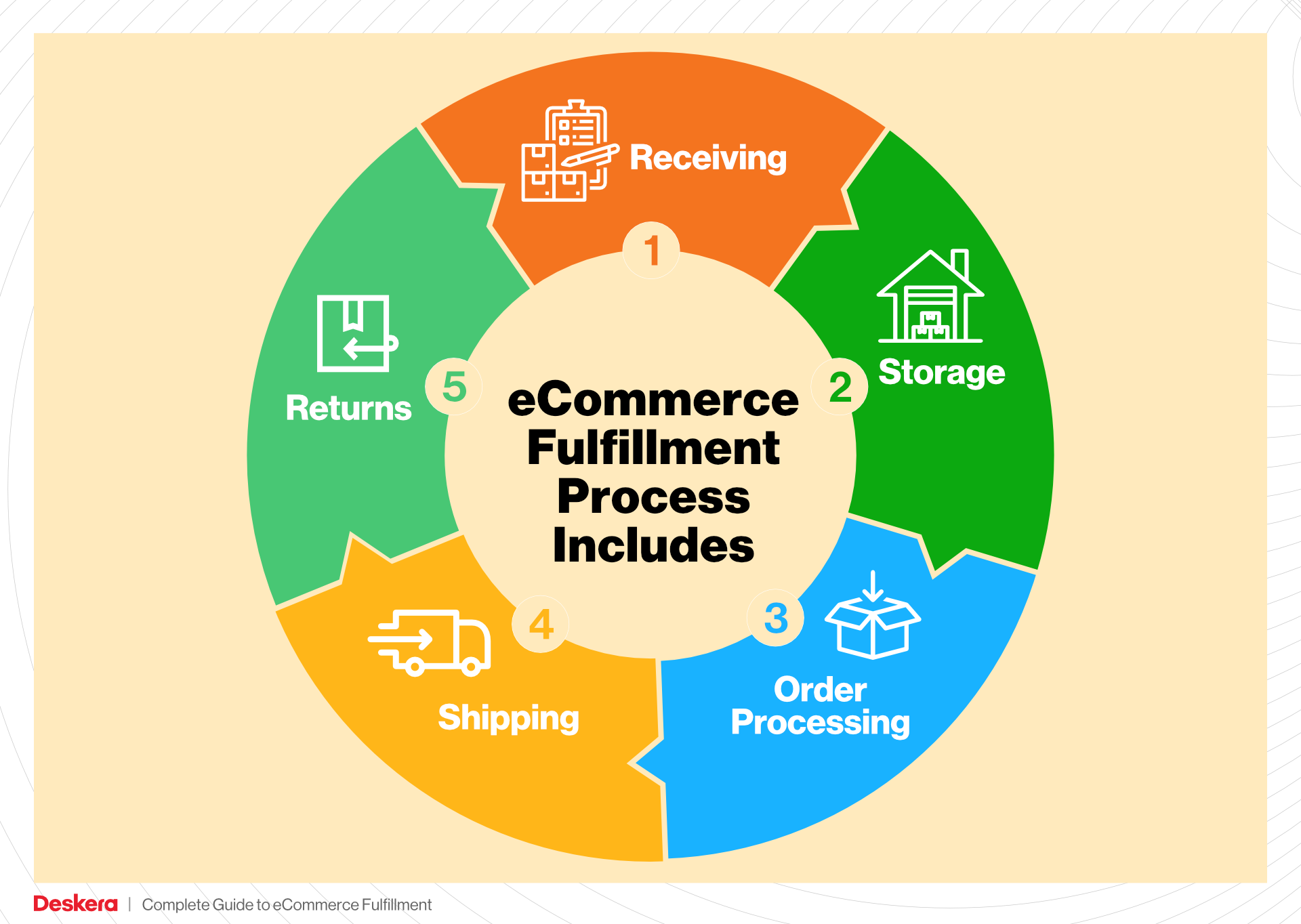
Finally, we will discuss pricing structures commonly associated with fulfillment services. Understanding these costs will empower you to budget effectively and choose a solution that provides the best value for your investment.
Empowering Smart Logistics Decisions
Our goal with this guide is to empower you as a business owner or operations manager to make smart, strategic decisions about your logistics and fulfillment processes. By equipping yourself with knowledge about e-commerce fulfillment, you can alleviate the stress of order management, enhance your operational capabilities, and ultimately focus on what matters most—growing your business.
What You’ll Learn In This Guide
- What is E-commerce Fulfillment? An Introduction for Growing Businesses
- The Order Fulfillment Process: From ‘Buy’ Button to Customer’s Door
- Comparing Fulfillment Models: In-House vs. 3PL vs. Dropshipping
- A Deep Dive into Amazon FBA: Pros, Cons, and Who It’s For
- Core Services Offered by Fulfillment Centers
- How to Choose a Fulfillment Partner: A 6-Point Checklist
- Understanding Fulfillment Pricing: A Breakdown of Common Fees
- Frequently Asked Questions (FAQs) about Fulfillment
- Conclusion: Is Outsourcing Fulfillment the Right Move for Your Business?
- Important Disclaimer
The Order Fulfillment Process: From ‘Buy’ Button to Customer’s Door
1. Receiving Inventory
The order fulfillment process begins with receiving inventory, a critical step where products arrive at the fulfillment center from suppliers or manufacturers. During this phase, the items are checked against purchase orders to confirm that the correct quantities and specifications have been received. This verification process often involves using SKUs (Stock Keeping Units), unique identifiers for each product, which help streamline inventory management.
Receiving inventory is essential as it sets the foundation for the entire order fulfillment process. Accurate receiving ensures that the inventory records are up to date, which is crucial for maintaining stock levels and preventing stockouts. If discrepancies are found during receiving, they must be addressed immediately to avoid future complications in order processing.
2. Warehouse Storage
Once the inventory is received and verified, the next step is warehouse storage. In this phase, products are organized within the fulfillment center, often using a systematic approach to maximize space and efficiency. Items are typically categorized and stored based on various factors, such as size, weight, and demand frequency. Advanced Warehouse Management Systems (WMS) may be employed to optimize storage locations and facilitate easier access for order picking.
Proper warehouse storage is vital for several reasons. First, it enhances the speed and efficiency of order fulfillment by reducing the time it takes to locate products when an order is placed. Second, effective storage management minimizes the risk of inventory damage or loss. By strategically placing products, businesses can also improve their overall operational efficiency, ultimately leading to faster delivery times and increased customer satisfaction.
3. Order Picking
The order picking process occurs when a customer places an order, triggering the retrieval of the selected items from their storage locations. Employees or automated systems utilize pick lists, which outline the items to be collected for each order. This process can vary in complexity, ranging from single order picking (picking items for one order at a time) to batch picking (collecting items for multiple orders simultaneously).
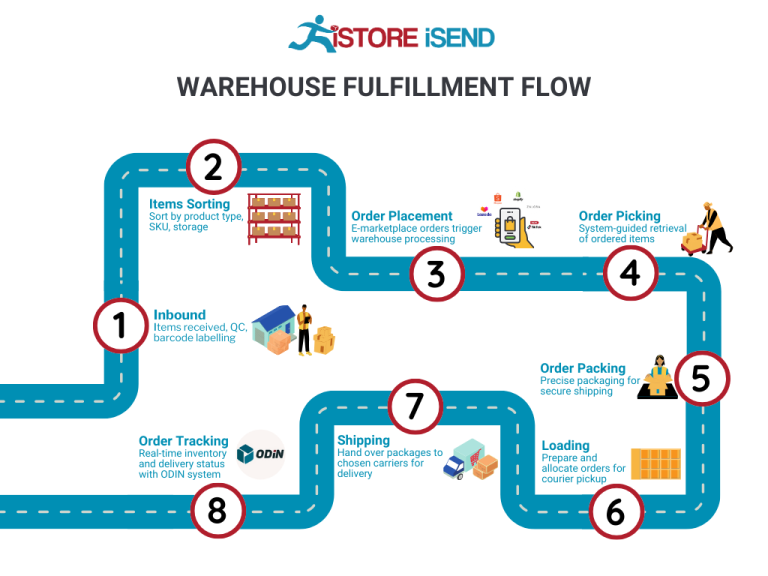
Order picking is crucial as it directly impacts the speed and accuracy of fulfilling customer orders. Efficient picking methods can significantly reduce the time it takes to process orders, which is essential in today’s fast-paced e-commerce environment. Moreover, accuracy during this step is paramount; errors in picking can lead to incorrect shipments, resulting in customer dissatisfaction and increased return rates.
4. Order Packing
After the items have been picked, they are moved to the packing station, where they undergo the packing process. During this phase, products are carefully packaged for shipment, ensuring they are protected during transit. Packing materials such as boxes, bubble wrap, and packing peanuts may be used, and orders often include packing slips that detail the contents. Additionally, businesses may implement branding elements—like custom tape or thank-you notes—to enhance the unboxing experience.
Order packing is a vital step that influences both the safety of the products and the overall customer experience. Properly packed orders minimize the risk of damage during shipping, which is crucial for maintaining customer satisfaction. Furthermore, an aesthetically pleasing and well-branded package can enhance customer perception of the business, encouraging repeat purchases and positive reviews.
5. Shipping & Delivery
The final step in the order fulfillment process is shipping and delivery, where the packed orders are dispatched to customers. This phase involves selecting the appropriate shipping carrier based on factors such as cost, delivery speed, and destination. Businesses often utilize shipping software to compare rates and print shipping labels efficiently, facilitating a smoother dispatch process.
Shipping and delivery are critical for customer satisfaction and can significantly affect a business’s reputation. Fast and reliable shipping is one of the key factors that customers consider when making a purchase decision. By providing accurate tracking information and timely updates, businesses can enhance the customer experience, reducing anxiety during the waiting period and fostering trust in the brand. Ultimately, efficient shipping and delivery processes can lead to higher customer retention rates and increased sales.
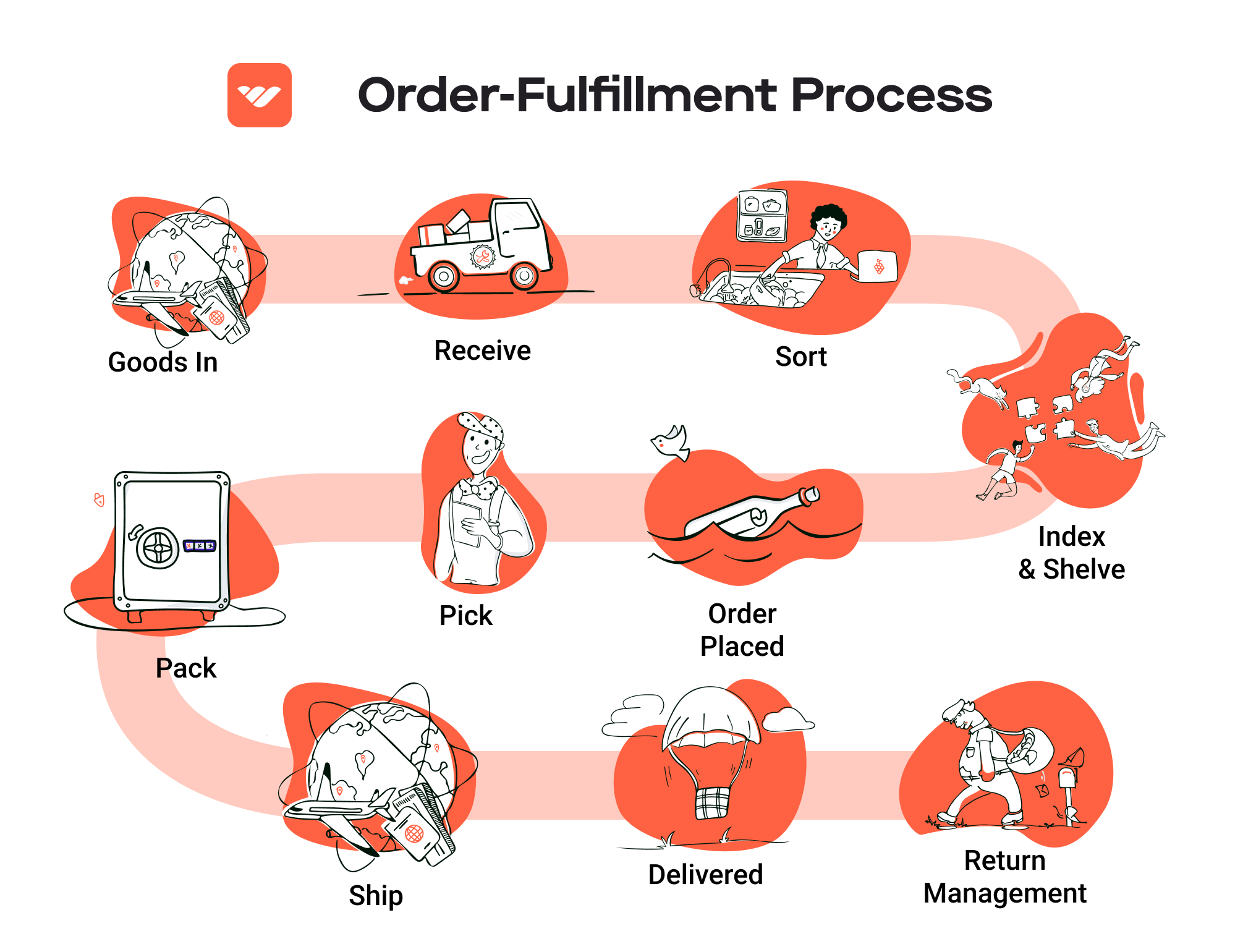
In conclusion, understanding and optimizing each step of the order fulfillment process is essential for e-commerce businesses looking to scale effectively. By focusing on each phase—from receiving inventory to shipping and delivery—businesses can enhance their operational efficiency, reduce costs, and improve customer satisfaction.
Comparing Fulfillment Models: In-House vs. 3PL vs. Dropshipping
Fulfillment Model Comparison
| Model | Who Handles Inventory | Best For (Business Stage) | Key Advantage | Key Disadvantage |
|---|---|---|---|---|
| In-House Fulfillment | The business itself | Established businesses with steady demand | Full control over operations and branding | High overhead costs and resource allocation |
| Third-Party Logistics (3PL) | A third-party logistics provider | Growing businesses needing scalability | Access to expertise and infrastructure | Less control over the fulfillment process |
| Dropshipping | Suppliers or manufacturers | Startups and businesses testing new products | Low upfront costs and inventory risk | Lower margins and potential shipping delays |
In-House Fulfillment
In-house fulfillment involves managing the entire order processing operation within the business itself. This model is most suitable for established companies that have a consistent order volume and the necessary infrastructure in place. The business retains full control over inventory management, order processing, and shipping, allowing for tailored branding and customer service experiences. The key advantage of in-house fulfillment is the ability to directly oversee operations, leading to potentially higher quality control and customer satisfaction. However, this model often comes with significant overhead costs, including warehousing, staffing, and technology investments. Additionally, the business must allocate resources to manage logistics, which can detract from focusing on core activities such as product development and marketing.
Third-Party Logistics (3PL)
Third-party logistics (3PL) providers offer a comprehensive range of logistics services, including warehousing, inventory management, order fulfillment, and shipping. This model is ideal for growing businesses that require scalability without the burden of managing logistics in-house. By partnering with a 3PL, companies can leverage the provider’s expertise, technology, and established infrastructure to streamline operations. The key advantage is that businesses can scale their operations quickly and efficiently, while also benefiting from reduced overhead costs associated with warehousing and logistics. However, a notable downside is the reduced control over the fulfillment process. Businesses must rely on their 3PL partner to maintain quality and timely delivery, which can sometimes lead to challenges in customer experience if the 3PL does not meet expectations.
Dropshipping
Dropshipping is a fulfillment model where the retailer does not hold inventory but instead transfers customer orders directly to a supplier or manufacturer, who then ships the products directly to the customer. This model is particularly advantageous for startups or businesses exploring new products, as it requires minimal upfront investment and eliminates the risk of unsold inventory. The key advantage of dropshipping is the low overhead costs, as businesses do not need to manage warehousing or inventory. However, dropshipping also comes with its own set of challenges, including lower profit margins and potential delays in shipping. Since the retailer is reliant on suppliers for inventory management and fulfillment, inconsistencies in product availability or shipping times can negatively impact customer satisfaction and brand reputation.
Conclusion
Selecting the right fulfillment model is crucial for e-commerce businesses aiming to scale effectively. In-house fulfillment offers control but at a higher cost, while 3PL provides scalability and expertise, albeit with some loss of control. Dropshipping serves as a low-risk entry point for new businesses but can lead to challenges in profitability and customer service. Each model has its unique advantages and disadvantages, and the choice ultimately depends on the specific needs, resources, and growth stage of the business.
A Deep Dive into Amazon FBA: Pros, Cons, and Who It’s For
Understanding Fulfillment by Amazon (FBA)
Fulfillment by Amazon (FBA) is a service provided by Amazon that allows sellers to store their products in Amazon’s fulfillment centers. Amazon then takes care of storage, packaging, shipping, and customer service for these products. This service has gained significant traction among e-commerce businesses as it provides a streamlined solution for order fulfillment while leveraging Amazon’s extensive logistics network.
How FBA Works
- Product Listing: Sellers create product listings on Amazon and choose to enroll their products in the FBA program.
- Inventory Shipment: Sellers send their inventory to Amazon’s fulfillment centers. Amazon provides guidelines on how to prepare and package these products to ensure they are suitable for storage and shipping.
- Storage: Once received, the products are stored in Amazon’s warehouses until they are sold.
- Order Processing: When a customer orders a product, Amazon picks, packs, and ships the item on behalf of the seller.
- Customer Service and Returns: Amazon also handles customer inquiries and returns, providing a seamless experience for buyers.
- Payment Processing: After the sale, Amazon processes payments and transfers the seller’s earnings, minus any applicable fees.
Pros of Using FBA
1. Prime Eligibility
One of the biggest advantages of FBA is that products become eligible for Amazon Prime. This means that Prime members can receive free two-day shipping on eligible items, which can significantly boost sales. Prime customers tend to prefer Prime-eligible products, creating a competitive advantage for sellers using FBA.
2. Enhanced Customer Trust
Products fulfilled by Amazon carry the trust and reliability associated with the Amazon brand. Customers are more likely to purchase items that are backed by Amazon’s fulfillment service due to its reputation for quality service, fast shipping, and easy returns.
3. Multi-Channel Fulfillment
FBA isn’t limited to just sales on Amazon. Sellers can utilize FBA for multi-channel fulfillment, meaning they can also fulfill orders from their own websites or other platforms using Amazon’s logistics network. This can simplify operations and improve efficiency for businesses selling across various channels.
4. Scalability
FBA allows businesses to scale without worrying about logistics. As sales increase, sellers can simply send more inventory to Amazon, and the fulfillment process remains consistent. This flexibility can be particularly beneficial for seasonal or fluctuating demand.
5. Time Savings
Outsourcing fulfillment to Amazon frees up sellers to focus on other aspects of their business, such as product development, marketing, and customer engagement. The comprehensive service offered by FBA allows business owners to allocate their time more effectively.
Cons of Using FBA
1. High Fees
One of the most significant drawbacks of FBA is the cost. Sellers incur various fees, including storage fees, fulfillment fees, and additional charges for long-term storage. These costs can add up quickly, especially for sellers with lower margins or those who have slow-moving inventory.
2. Strict Inventory Rules
Amazon has stringent inventory management policies. Sellers must adhere to these guidelines regarding product packaging, labeling, and shipment to avoid penalties. Failure to comply can lead to additional fees or even account suspension.
3. Commingling Risks
FBA uses a commingling system where products from different sellers are stored together. While this can streamline operations, it poses risks, such as mislabeling or shipping the wrong product to customers. If a seller’s inventory is mixed with that of a lower-quality product, it can negatively impact their ratings and customer trust.
4. Loss of Control
By using FBA, sellers relinquish some control over the fulfillment process. This can be concerning for businesses that prefer to manage their own logistics or those that want to ensure a specific packaging experience for their customers.
5. Limited Customization
Sellers have limited options when it comes to branding and packaging when using FBA. All products are shipped in Amazon-branded packaging, which may detract from a seller’s ability to create a unique unboxing experience for their customers.
Who is FBA Best For?
Fulfillment by Amazon is particularly beneficial for small to medium-sized e-commerce businesses that are looking to scale quickly without the overhead associated with warehousing and logistics. It is ideal for:
- New Sellers: Those who are just starting and may not have the capital to invest in their own fulfillment infrastructure.
- High-Volume Sellers: Businesses with high sales volumes that require efficient logistics solutions to manage order fulfillment seamlessly.
- Seasonal Sellers: Companies that experience spikes in sales during specific times of the year can benefit from the flexible nature of FBA without the need for long-term storage solutions.
- Brands Looking to Expand: Sellers aiming to tap into Amazon’s vast customer base and leverage its logistics capabilities to grow their market presence.
In conclusion, while FBA offers numerous advantages that can help businesses streamline their operations and enhance customer satisfaction, it is essential for sellers to weigh these benefits against the potential downsides, particularly the costs and lack of control over the fulfillment process. Understanding these dynamics will help e-commerce entrepreneurs make informed decisions about whether FBA is the right choice for their business model.
Core Services Offered by Fulfillment Centers
Inventory Management & Warehousing
Inventory management and warehousing are foundational services provided by fulfillment centers. This process involves the systematic oversight of inventory levels, orders, sales, and deliveries. Fulfillment centers utilize sophisticated inventory management systems to track products in real-time, ensuring that stock levels are accurately maintained and replenished as needed.
The benefits of effective inventory management for e-commerce businesses are substantial. First, it minimizes the risk of stockouts or overstock situations, both of which can lead to lost sales and increased holding costs. By having a clear view of inventory levels, businesses can make informed purchasing decisions, optimize their stock turnover rates, and improve cash flow. Moreover, fulfillment centers often provide scalable storage solutions, allowing e-commerce businesses to adjust their warehouse space according to seasonal demand fluctuations without the financial burden of maintaining a large in-house facility.
Pick and Pack Services
Pick and pack services are essential for efficiently fulfilling customer orders. This process begins when an order is placed; fulfillment center staff “pick” the ordered items from the warehouse shelves, and then “pack” them securely for shipment. This service often includes the use of automated systems and technology to streamline the picking process, reduce errors, and speed up order fulfillment.
For e-commerce businesses, the benefits of pick and pack services are manifold. They enable faster order processing and shipping times, which are crucial for maintaining customer satisfaction in a competitive market. Additionally, accuracy in picking and packing reduces the likelihood of returns and exchanges due to incorrect items being sent, thereby enhancing the overall customer experience. By outsourcing this labor-intensive task to a fulfillment center, businesses can also free up valuable internal resources, allowing them to focus on growth strategies and customer engagement.
Kitting and Assembly
Kitting and assembly involve the process of grouping multiple products into a single package or kit, which can be especially beneficial for businesses that sell products that are often used together. This service may include assembling items, packaging them together, and preparing them for shipment. Kitting can also involve creating customized packages tailored to specific customer needs or promotional offerings.
The value of kitting and assembly for e-commerce businesses lies in its ability to enhance product offerings and streamline fulfillment. By offering bundled products, businesses can increase average order value and provide customers with a convenient shopping experience. Additionally, this service can simplify inventory management, as businesses can track and manage kits as single units rather than as individual items. This not only saves time during the fulfillment process but can also lead to improved customer satisfaction as they receive well-presented, ready-to-use products.
Returns Management (Reverse Logistics)
Returns management, also known as reverse logistics, is a critical service provided by fulfillment centers that focuses on efficiently handling returned products. This service includes receiving returned items, inspecting their condition, restocking them if they are sellable, and managing any necessary repairs or refurbishments. A streamlined returns process is vital for maintaining customer trust and loyalty.
For e-commerce businesses, effective returns management offers several advantages. First, it enhances customer satisfaction by providing a hassle-free return experience, which can be a significant factor in a customer’s decision to shop with a brand. A well-managed returns process can also minimize losses by ensuring that products are quickly returned to inventory and made available for resale. Furthermore, fulfillment centers often provide data analytics on returns, enabling businesses to identify trends and address potential issues with products or customer expectations. By outsourcing returns management, e-commerce businesses can also optimize their internal operations, focusing on growth and customer engagement rather than the complexities of reverse logistics.
Conclusion
In summary, fulfillment centers play a pivotal role in the success of e-commerce businesses by offering a range of core services including inventory management and warehousing, pick and pack services, kitting and assembly, and returns management. By leveraging these services, businesses can enhance operational efficiency, improve customer satisfaction, and ultimately drive sales growth. As e-commerce continues to evolve, partnering with a reliable fulfillment center can provide the strategic advantage needed to scale operations and meet the ever-changing demands of the market.
How to Choose a Fulfillment Partner: A 6-Point Checklist
Location & Warehouse Network
Importance:
The geographic location of your fulfillment partner’s warehouses plays a critical role in shipping speed and costs. A partner with strategically located warehouses can help reduce transit times and shipping expenses, enhancing customer satisfaction.
Questions to Ask:
1. Where are your warehouses located, and how many do you operate?
2. Do you have warehouses near my primary customer base?
3. What is your average shipping time to various regions?
4. Can you accommodate international shipping if I decide to expand?
Technology & Integrations
Importance:
In today’s e-commerce environment, technology is paramount. A fulfillment partner that utilizes advanced warehouse management systems (WMS) and offers seamless integrations with your e-commerce platform can streamline operations, enhance order accuracy, and provide real-time visibility into inventory levels.
Questions to Ask:
1. What technology do you use for inventory management and order processing?
2. Can your systems integrate with my e-commerce platform (e.g., Shopify, WooCommerce)?
3. Do you provide tracking capabilities for both orders and inventory?
4. How do you handle system outages or technical issues?
Specializations (e.g., Cold Storage, Oversized Items)
Importance:
Different businesses have unique needs, such as handling temperature-sensitive products or oversized items. Choosing a partner that specializes in your specific requirements ensures your products are stored and handled appropriately, reducing the risk of damage and compliance issues.
Questions to Ask:
1. What types of products do you specialize in storing and fulfilling?
2. Do you have facilities for cold storage or specialized handling?
3. How do you manage compliance with regulations for specific product types?
4. Can you accommodate seasonal fluctuations in inventory or product types?
Scalability & Capacity
Importance:
As your business grows, your fulfillment needs will evolve. A partner that can scale with your business ensures you don’t have to switch providers during critical growth phases. Understanding their capacity helps you plan your inventory and logistics effectively.
Questions to Ask:
1. What is your current fulfillment capacity, and how do you handle peak seasons?
2. How quickly can you scale operations if my order volume increases?
3. Do you have a plan in place for managing unexpected spikes in demand?
4. What kind of support can you provide if I need to expand into new markets?
Pricing and Contracts
Importance:
Understanding the pricing structure and contract terms is crucial for budgeting and financial planning. Transparent pricing helps avoid unexpected fees and ensures you are getting a fair deal. Pay attention to the terms of the contract, including any minimum commitments or penalties.
Questions to Ask:
1. What is your pricing model (e.g., per order, per item, storage fees)?
2. Are there any additional costs (e.g., for returns, special handling)?
3. What are the terms of the contract, and is there flexibility for renegotiation?
4. Can you provide a detailed breakdown of all costs associated with your services?
Customer Support & Reviews
Importance:
Effective customer support is essential for resolving issues quickly and maintaining smooth operations. Reading reviews and testimonials can provide insights into the partner’s reliability and service quality. A responsive support team can significantly impact your fulfillment experience.
Questions to Ask:
1. What customer support channels do you offer (e.g., phone, email, chat)?
2. What are your support hours, and how quickly can I expect a response?
3. Can you provide references or case studies from businesses similar to mine?
4. How do you handle complaints or issues related to order fulfillment?
Conclusion
Choosing the right fulfillment partner is a critical decision that can significantly impact your e-commerce operations. By using this checklist, you can ensure that you cover all essential aspects of a potential partnership, allowing you to make an informed choice that aligns with your business goals. Remember, a good 3PL partner not only fulfills orders but also becomes an integral part of your supply chain strategy, enabling you to focus on growth and customer satisfaction.
Understanding Fulfillment Pricing: A Breakdown of Common Fees
Initial Setup Fees
Initial setup fees are often the first costs incurred when partnering with a 3PL fulfillment provider. These fees can cover a variety of services, including account setup, integration with your e-commerce platform, and configuration of your inventory management system. Providers may charge a one-time fee for onboarding, which can range from a few hundred to several thousand dollars, depending on the complexity of your operations and the capabilities of the 3PL.
To calculate these fees, consider the following factors:
– Complexity of Integration: More complex e-commerce platforms or custom-built systems may incur higher costs.
– Volume of SKUs: A higher number of SKUs may require additional time and resources for setup.
– Required Customization: If your business needs specific integrations or custom workflows, expect these to add to the initial setup cost.
Receiving Fees
Receiving fees are charged when inventory arrives at the fulfillment center. This fee covers the labor and resources required to unload, inspect, and enter your products into the inventory management system.
Typically, receiving fees are calculated based on:
– Volume: Fees may be charged per pallet, box, or item received.
– Handling Complexity: If your products require special handling (e.g., fragile items), additional fees may apply.
– Time of Receipt: Some 3PLs may charge different rates for peak times when receiving volumes are higher.
It’s essential to understand the receiving process and associated fees, as they can significantly impact your overall fulfillment costs.
Storage Fees (per pallet/bin)
Storage fees are charged for the space your inventory occupies within the fulfillment center. These fees are typically calculated on a monthly basis and can vary depending on the storage method—per pallet, per bin, or per cubic foot.
Key factors influencing storage fees include:
– Storage Type: Pallet storage may be cheaper than bin storage, especially for large quantities of bulk items.
– Duration: Many providers will charge different rates based on the length of time your inventory is stored, with longer durations potentially incurring higher fees.
– Seasonality: During peak seasons, storage fees may increase due to higher demand for warehouse space.
Understanding your storage needs and how the 3PL calculates these fees can help you manage inventory costs effectively.
Pick & Pack Fees (per item/order)
Pick and pack fees are charged for the labor involved in retrieving items from storage, packing them for shipment, and preparing them for delivery. This fee is usually calculated on a per-item or per-order basis.
Factors that influence pick and pack fees include:
– Order Complexity: Orders with multiple items or requiring special packaging may incur higher fees.
– Volume Discounts: Many 3PLs offer tiered pricing, where the per-order fee decreases as the volume of orders increases.
– Automation: Facilities with advanced automation technologies may offer lower pick and pack fees due to increased efficiency.
These fees can add up quickly, especially for businesses with high order volumes, so it’s important to evaluate potential 3PL partners based on their pick and pack pricing structures.
Shipping Fees
Shipping fees are one of the most significant costs associated with fulfillment and can vary widely based on several factors, including destination, package size, weight, and shipping method (standard, expedited, etc.).
To assess shipping fees, consider:
– Carrier Partnerships: Many 3PLs have established relationships with shipping carriers and can offer discounted rates based on volume.
– Shipping Zones: Costs can vary depending on how far packages need to travel; shipping to distant regions may incur higher fees.
– Dimensional Weight Pricing: Carriers often charge based on the size of the package rather than just its weight, which can affect shipping costs for bulkier items.
Understanding how shipping fees are structured will enable you to make more informed decisions about which 3PL provider to partner with.
Tips for Getting an Accurate Quote
-
Provide Detailed Information: When requesting a quote, provide as much detail as possible about your business, including order volumes, inventory types, and expected growth. This helps 3PLs give a more accurate estimate.
-
Ask About Hidden Fees: Inquire about any potential hidden fees that may not be included in the initial quote, such as surcharges for peak seasons, special handling, or returns.
-
Compare Multiple Quotes: Don’t settle for the first quote you receive. Compare offers from several 3PLs to understand the range of services and pricing models available.
-
Negotiate: Many 3PLs are willing to negotiate terms and pricing, especially if you can demonstrate a higher volume of business.
-
Request a Trial Period: If possible, negotiate a trial period with the 3PL to evaluate their services and fees before committing long-term.
By understanding these common fulfillment pricing models and following these tips, e-commerce business owners can make informed decisions that align with their growth strategies and budgetary constraints.
Frequently Asked Questions (FAQs) about Fulfillment
1. What is a 3PL (Third-Party Logistics) company?
A 3PL company provides comprehensive logistics services for businesses, including warehousing, inventory management, order fulfillment, shipping, and freight forwarding. By outsourcing these functions to a 3PL, businesses can focus on their core competencies while benefiting from the expertise and resources of logistics specialists.
2. How does 3PL order fulfillment work?
3PL order fulfillment involves several steps: receiving inventory at the fulfillment center, storing products, processing orders from e-commerce platforms, picking and packing items, and shipping them to customers. Additionally, 3PL providers often manage returns and offer reporting and analytics to help businesses optimize their operations.
3. What’s the difference between a warehouse and a fulfillment center?
While both warehouses and fulfillment centers store goods, their functions differ. A warehouse primarily serves as a long-term storage facility, focusing on inventory holding. In contrast, a fulfillment center is designed for rapid order processing, where products are constantly moving in and out to meet customer demands, often involving value-added services like packing and shipping.
4. How much do fulfillment services cost?
The cost of fulfillment services varies based on several factors, including the volume of orders, the type of products, storage space required, and additional services such as kitting or returns handling. Typically, costs include warehousing fees, order processing fees, and shipping charges. Requesting quotes from multiple 3PL providers can help you find the best pricing for your needs.
5. What are the benefits of using a 3PL for order fulfillment?
Using a 3PL offers several advantages, including reduced operational costs, increased efficiency, access to advanced technology, and scalability. By outsourcing fulfillment, businesses can enhance their customer service through faster shipping and improved inventory management while freeing up internal resources for growth and innovation.
6. Can a 3PL handle international shipping?
Yes, many 3PL providers specialize in international shipping and logistics. They can manage customs clearance, provide guidance on international shipping regulations, and offer solutions for navigating tariffs and duties. This capability allows businesses to expand their market reach beyond domestic borders.
7. What types of businesses benefit from 3PL services?
3PL services are beneficial for a variety of businesses, including e-commerce startups, small to medium-sized enterprises, and large corporations looking to streamline their logistics. Companies that experience seasonal fluctuations in demand or those entering new markets can particularly benefit from the flexibility and scalability offered by 3PL providers.
8. How do I choose the right 3PL provider for my business?
When selecting a 3PL provider, consider factors such as their experience in your industry, the range of services they offer, technology integration capabilities, and customer service reputation. Additionally, assess their fulfillment speed, scalability options, and pricing structure to ensure they align with your business needs and growth objectives.
9. What technology is used in 3PL order fulfillment?
3PL providers typically employ advanced technology, including warehouse management systems (WMS), inventory management software, and order processing platforms. These technologies facilitate real-time tracking, inventory control, and automated order processing, enhancing efficiency and accuracy throughout the fulfillment process.
10. How can I integrate my e-commerce platform with a 3PL?
Most 3PL providers offer integration options with popular e-commerce platforms such as Shopify, WooCommerce, and Amazon. This integration allows for seamless data exchange regarding inventory levels, order processing, and shipping updates. Working closely with your chosen 3PL to set up this integration can streamline your operations and improve customer experience.
Conclusion: Is Outsourcing Fulfillment the Right Move for Your Business?
Evaluating the Benefits of Outsourcing Fulfillment
Outsourcing your fulfillment operations can be a game-changer for your e-commerce business. One of the primary benefits is the significant time savings that come from delegating logistics to a third-party logistics (3PL) provider. By freeing your team from the complexities of inventory management, order packing, and shipping, you can redirect valuable resources towards strategic initiatives like product development and marketing, ultimately driving growth.
Scalability is another critical advantage. As your business expands, so do your logistical needs. 3PL partners are equipped to scale operations up or down based on demand fluctuations, allowing you to respond swiftly to market changes without the need for significant capital investment in infrastructure. This flexibility ensures that you can meet customer expectations for timely delivery, which is vital in today’s competitive landscape.
Additionally, leveraging the expertise of a 3PL provider can enhance the efficiency and accuracy of your fulfillment process. These companies specialize in logistics and have established best practices, advanced technology, and strategic partnerships that can optimize your supply chain. Their knowledge can lead to improved shipping rates, faster processing times, and enhanced customer satisfaction.
However, the success of outsourcing fulfillment hinges on selecting the right partner. Conduct thorough research to ensure the 3PL aligns with your business goals and can accommodate your specific needs. A misalignment could lead to operational inefficiencies and customer dissatisfaction.
Take Action
Now is the time to assess your current fulfillment strategy. Conduct an audit of your shipping process to identify pain points and inefficiencies. Consider whether a fulfillment partner could alleviate these challenges and support your business’s growth trajectory. By taking this strategic step, you position your e-commerce business for sustained success in a rapidly evolving marketplace.
Important Disclaimer
⚠️ Important Disclaimer
The information in this guide is for educational purposes. Fulfillment services, pricing, and platform features change frequently. Always conduct your own due diligence and consult with providers directly before making business decisions.
